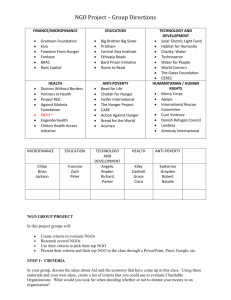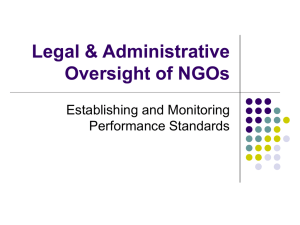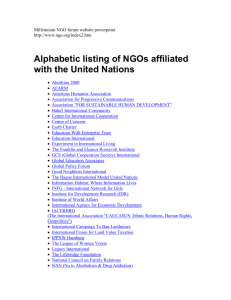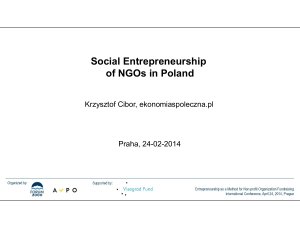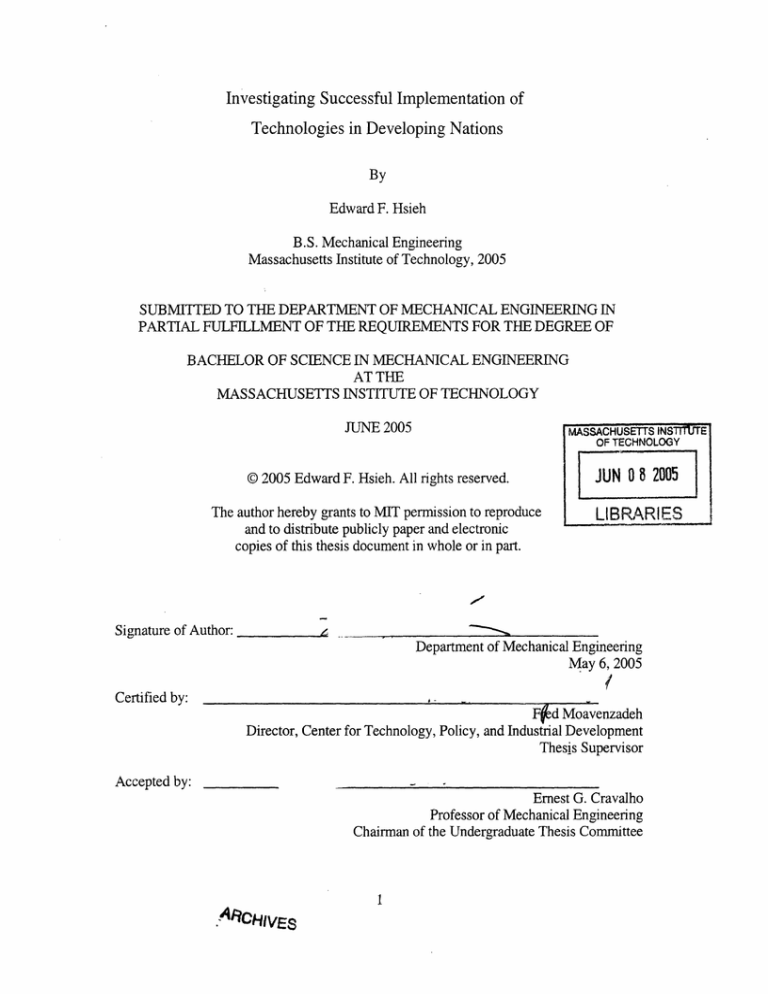
Investigating Successful Implementation of
Technologies in Developing Nations
By
Edward F. Hsieh
B.S. Mechanical Engineering
Massachusetts Institute of Technology, 2005
SUBMITTED TO THE DEPARTMENT OF MECHANICAL ENGINEERING IN
PARTIAL FULFILLMENT OF THE REQUIREMENTS FOR THE DEGREE OF
BACHELOR OF SCIENCE IN MECHANICAL ENGINEERING
AT THE
MASSACHUSETTS INSTITUTE OF TECHNOLOGY
JUNE 2005
MASSACHUSETTS INSTMUTE
OF TECHNOLOGY
© 2005 Edward F. Hsieh. All rights reserved.
JUIN 0 8 2005
The author hereby grants to MIT permission to reproduce
and to distribute publicly paper and electronic
copies of this thesis document in whole or in part.
LIBRARIES
z
Signature of Author:
Department of Mechanical Engineering
May 6, 2005
¥
Certified by:
F6d Moavenzadeh
Director, Center for Technology, Policy, and Industrial Development
Thesis Supervisor
Accepted by:
Ernest G. Cravalho
Professor of Mechanical Engineering
Chairman of the Undergraduate Thesis Committee
1
.ARCHIVES
Investigating Successful Implementation of
Technologies in Developing Nations
By
Edward F. Hsieh
Submitted to the Department of Mechanical Engineering
On May 6, 2005 in Partial Fulfillment of the
Requirements for the Degree of Bachelor of Science in
Mechanical Engineering
ABSTRACT
A study was performed to determine possible factors that contribute to successful
implementation of new technologies in developing nations. Engineers and other inventors
have devoted great effort to Appropriate Technology design over the last two decades,
but few comprehensive case studies currently exist examining factors that lead to
technology success. Existing studies of appropriate technology were summarized and a
quantitative model was created to tabulate the data.
Factors of local maintenance, local production, and local need of a technology were
found to be the most important to sustainable technology implementation. The model was
then tested with a current Appropriate Technology project to examine the relevance of its
results. Overall, the model proved applicable, though furthers studies are suggested to
refine the model.
Thesis Supervisor: Fred Moavenzadeh
Title: Director of the Center for Technology, Policy, and Industrial Development
-2-
Table of Contents
1
2
Appropriate Technology Overview........................................................................ - 4 -
1.1
Relevance...................................-
1.2
History............................................................................................................ - 5-
Procedure................................................................................................................
2.1
3
4-
-6-
Appropriate Technology Definition ...............................................................- 8 -
Existing Research...................................................................................................- 9 -
3.1 Cases..........................................................................................................
9-Case 1: Nala Plugs in India .................................................................................... -9 Case 2: Boreholes in Mozambique .......................................................................-
10 -
Case 3: Upesi Stoves in Kenya ............................................................................-
11 -
Case 4: Mark II Handpumps in India ...................................................................-
11 -
Case 5: Photovoltaics in Zimbabwe .....................................................................-
12 -
Case 6: Photovoltaics in the Marshall Islands ......................................................-
13 -
4
Results..................................................................................................................-
14 -
5
Analysis................................................................................................................- 16-
6
7
5.1
Most Positive Factors ...................................................................................- 16 -
5.2
Least Positive Factors ................................................................................... 16
- -
Application...........................................................................................................-
18-
6.1
Description of the SWDD Case ...................................................................- 18 -
6.2
Applying the Model ..................................................................................... - 19 -
Conclusion............................................................................................................ -20 7.1
Using the Model ...........................................................................................- 20-
7.2
Future Steps .................................................................................................. - 21-
Appendix A: Factor data ..........................................................-
-3-
22 -
1
Appropriate Technology Overview
1 1
Relevance
The term "Appropriate Technology" (AT), taken literally, would seem to apply to
virtually any technology that has a suitable use in some arena. The commonly understood
meaning, however, lies closer to the definition provided by the U.S. Congress's Office of
Technology Assessment: that AT is "usually associated with small-scale, decentralized
industries that make extensive use of an abundant resource" in developing countries' .
Typically, Appropriate Technologies are implemented by organizations from
industrialized nations such as the United States and attempt to cater the design and
implementation to the specific characteristics of the target communities.
The need for AT design is fueled by the vast inequalities and debilitating poverty
found throughout the world today. According to the World Bank2, living standards
around the world rose over the last two decades; at the same time, however, 1.1 billion
people still live in extreme economic poverty, earning less than $1 per day. In SubSaharan Africa, an additional 150 million people joined this category since 1981. In
terms of water supply alone, 2.2 million deaths occur every year from diarrheal illnesses
because of a lack of access to clean drinking water in developing countries. In the area of
public health and disease control, every year 8.5 million new cases of tuberculosis arise
and 2 million people die from the disease, despite the fact that drugs exist that can cure
the disease. Appropriate Technology design employs the goal of creating technologies
that can lift people out of poverty, both by stimulating the local economies via job and
I Office of Technology Assessment (1981). An Assessment of Technology for Local Development, (GPO
Stock No. 052-003-00797-5). U.S. Government Printing Office, Washington, DC.
2
"Understand Poverty." Poverty Net. The World Bank Group: 28 April 2005.
<http://web.worldbank.org/WBSITE/EXTERNAL>
-4-
market creation, and by direct production benefits that can result from new technology.
While millions of dollars have been spent developing new appropriate technologies,
quantitative studies on the techniques for implementing AT are notably absent. This
thesis looks to identify key success factors in delivering sustainable technology to
developing countries.
1.2
History
The origins of the modern Appropriate Technology movement can mainly be
attributed to EI.F.Schumacher and his 1973 book Small is Beautiful3 . Schumacher, a top
economic planner for Britain, had worked as an economic consultant to Burma and India,
where he gained the inspiration for writing his book. The main focus of his book was on
job creation resulting from AT. Instead of using Western models for capital investment in
a firm of the Third World, Schumacher argued that an "intermediate technology" model
would have much more success in this environment. The intermediate technology should
have improvements over the existing technologies in the developing country, but cost less
and require less extensive training to operate than high-technology from Western
countries.
Since Schumacher's book was published, Appropriate Technology has gone
through various incarnations and movements as Westerners adopted the idea. In 1975,
around 500 organizations or institutions had an AT focus; by 1980, this number doubled
to over 1000. In the 1970s, a second culture seemed to arise out of the original AT
movement, one resulting from the counter-culture anti-industrial movement of the 60s
and 70s. This environmentally-focused group supported AT, but in reality their emphasis
3 Schumacher, E. F. (1973). Small is Beautiful. Harper & Row, New York.
-5-
on the natural ran somewhat counter to the technological advances needed to really raise
people in slums out of poverty 4 . The AT movement also went through a "better
mousetrap" phase in the 1980s, during which many AT workshops around the world
filled with technological gadgetry that never succeeded in the field as a result of a lack of
dissemination efforts. This problem, the challenge of not just creating technologies, but
of implementing sustainable technologies in the developing world, serves as the main
driver for this thesis.
2
Procedure
First, background research was conducted on previous literature analyzing AT
cases. Selected cases were taken from the literature and summarized in Section 3. The
overall goal in selecting and analyzing the data was to find common themes among a
large number of AT studies that could be used to create guidelines for future work. To
improve relevanmce,
articles describing higher-level management theories like multinational corporation (MNC) strategies, marketing, or operational research were rejected.
Additionally, articles written before 1980 were likewise rejected to improve relevance.
Shown in Figure 1, a chart with 10 possible success factors was then created to
sort and analyze the results found in the research. Using this matrix, the effects of the
factors were converted into mathematical values to compare the relative importance of
the factors in technology sustainability.
4
Smillie, Ian. (2000). Mastering the Machine Revisited. ITDG Publishing, London.
-6-
Case 1
Case 2
Case 3
Case 4
Case 5
Case 6
Case 7
Factors
Familiar
Technology
Local NGO
Int'l NGO
0
Gov't
Local Input
Local
Production
Comm
Training
Local Maint
Financial
Local Need
* Present, Positive Effect o Present, Negative Effect - Not Present, Negative Effect
Blank means not addressed by author or unclear affect
Figure 1: Sample Factors Chart
First, the cases were first separated into two groups: cases deemed successes were
placed in the "successful" product group, S; cases that failed were placed in the
"unsuccessful"' group, U. The effects of the factors present in S were factored into a
variable, PE. The PE of a factor was increased or decreased by 2 based on whether the
factor had a positive or negative effect on the case. The PE was further modified by the
number of times the factor had a "Not Present, Negative Effect" in U. This weighted
value was termed the Strong Positive, or SP. For example, "Familiar Technology"
received an SP' of 6 and was modified by 1 to have an SP of 7, whereas "Government"
received an SF' of -2, was modified by 3, resulting in an SP of 1. The SP of a factor
represents the maximumpotential positive effect of a factor.
The SPwas then further modified by to take into account negative effects of
factors on unsuccessful cases. Each "Present, Negative Effect" case in the U group for a
factor decreased the SP by 1. Thus each factor was assigned a final adjusted value, P. The
resulting P values were then analyzed and interpreted in Section 5.
Using the results of the model created, an implementation plan was made in
Section 6 for a current AT project under development. The project, involving solar water
disinfection using polyethylene bags, shares characteristics similar to the other projects
reviewed: it is a relatively simple, low-cost intermediate technology that has a very large
potential market. The relevance of the information provided by the model was then
interpreted and conclusions were drawn about the relevance of the model.
2.1
Appropriate Technology Definition
Since the term "Appropriate Technology" covers decades of work in fields
ranging from mechanical devices to macroeconomic theories to software programs to
public policies, the use of AT will be restricted for the remainder of this paper. Thus AT
will refer only to physical technologies of a mainly mechanical nature implemented by
individuals or small groups outside North America and Europe. This means that AT
services such a.sthe Grameen Phone or Grameen Bank will not be addressed in this
paper. Additionally, this paper will not look at technology implementation or
management for MNCs, but rather technologies that a single inventor or small nongovernmental organization (NGO) could implement. The study of technology transfer
management for MNCs comprises an entire field in and of itself, and includes very
different implementation requirements than those related to small-scale organizations.
Also, this paper will not look at technology transfer in Eastern European countries;
-8-
although these countries can be considered developing countries, the different economic
conditions would again create a different set of requirements for this study.
3
Existing Research
The original intent of the literature review was to examine studies that analyzed
multiple AT cases and that quantitatively analyzed the results. Although many books
have been written on technology transfer for MNCs, and many more have been written
concerning macroeconomic or public policy issues related to AT, very little literature
could be found on the subject given the low-technology AT definition stated above.
Instead of looking at previous multiple-case studies, then, individual case studies were
chosen and analyzed.
3.1
Cases
Case 1: Nala Plugs in India
Source:By the People,For the People: Smalland SustainableDams Help Revitalize
Indian Communities and Groundwater, by Patrick McCully5 .
This study looks at small dams, called "nala plugs," implemented in Saurashtra,
India. These dams create surface water for feeding livestock and washing clothes, as well
as vital groundwater for farmers in the arid plains. Before the nala plugs existed, women
would have to walk miles away to fetch water and rely on monsoons for the supply. The
nala plugs project was started in 1995 by the Kundla Country Villages Service Center, a
Gandhian NGO. Since then more than 1,000 plugs have been built in 35 villages.
ImplementationFactors
McCully, Patrick. "By the People, For the People: Small and Sustainable Dams Help Revitalize Indian
Communities and Groundwater." Multinational Monitor. Washington: Apr 1999. Vol. 20, Iss. 4.
5
-9-
The nala plugs project succeeds where a previous government-built water system
failed. A primary reason for this, according to McCully, is the project's intimate relation
to the people. Village committees decide where the plugs should be built and then assign
user groups to them. These groups then have the responsibility of maintaining the
structures, which helps create a sustainable system. Additionally, the dams use
technology based on older Indian practices, ensuring effectiveness and acceptability in
the region.
Case 2: Boreholes in Mozambique
Source: Sustainable Water Supplyfor a Remote Rural Community in Mozambique:
Oxfam Australia and the Chicomo Rural Development Project, by Elizabeth Mann6 .
Mann describes the effort by Oxfam Australia to improve water supply using
maintainable boreholes in the Inhambane Province of Mozambique. Of an estimated
250,000 hand pumps in Africa, less than half are in working order. Oxfam Australia
discovered in 1994that many boreholes in Inhambane were destroyed by war, and has
worked on building 27 boreholes serving over 12,000 people since then.
ImplementationFactors
Similar to the case with nala plugs, village representatives used a consensus
system to pick most borehole locations. In three cases, local leaders picked the area. Also,
communities formed groups around the pumps and collected money for maintenance of
the pump. Because of new Mozambique legislation, Oxfam was forced to ask
communities to collect the equivalent of US$50 before installing pumps. This was a
difficult change for some communities, as water supplies were previously provided for
6
Mann, Elizabeth. "Sustainable Water Supply for a Remote Rural Community in Mozambique: Oxfam
Australia and the Chicomo Rural Development Project." Greener Management International. Sheffield:
Summer 2003., Iss. 42.
-10-
free. In retrospect, the new pay system could have transitioned better if Oxfam had
explained the requirement to local leaders. Oxfam also employed three technicians to
train the communities to ensure that each site had numerous people who could dismantle
and reassemble the pumps.
Case 3: Upesi Stoves in Kenya
Source: Stoves for Rural Livelihoods, by Smail Khennas7
This article looks critically at the problems in commercializing the Upesi woodburning stove in rural Kenya. The Upesi stove improves upon the stoves being used in
poor communities by reducing the amount of fuel required for use and improving overall
safety. It was chosen out of five designs tested in five regions of Kenya in a project
implemented in 1990 by the Intermediate Technology Development Group (ITDG) and
the Kenya Energy and Environment Organization (KENGO). In five years, ITDG has
trained more than 13 women's groups to make an Upesi stove.
ImplementationFactors
Khennas's article emphasizes the differences between ITDG's implementation of
the stove and the process taken by another group called GTZ. ITDG trained groups that
had easy access to clay, the material needed to produce the stoves. In contrast, GTZ
constructed kilns costing more than a thousand US dollars and gave them to
entrepreneurs or women's groups. Additionally, ITDG trained the women's groups in
how to price the Upesi, whereas GTZ subsidized the stoves and controlled the prices in
order to improve dissemination.
Case 4: Mark II Handpumps in India
7
Khennas, Smail. "Stoves for Rural Livelihoods."
Technology for Sustainable Livelihoods. Intermediate
Technology Development Group: 18 April 2005. < http://livelihoodtechnology.org>
-11-
Source: High-Impact Appropriate Technology Case Studies, by Thomas Fricke8
The Mark II Deepwell Handpump is a highly successful, publicly accessible water
pump design implemented in India, Asia, and Africa. It includes an extremely durable
design and can serve 200-250 people per installation on average. The Mark II was created
by the U.N. Children's Fund (UNICEF) in cooperation with the Indian government in the
1970s. To date, more than 600,000 Mark II pumps have been installed in India, while
another 20,000 have been exported to other countries.
ImplementationFactors
The Mark II has achieved widespread success for many reasons. In terms of the
design, the pump is very durable compared to previous designs; the materials used are of
indigenous origin; maintenance issues do not require highly trained specialists; and the
cost is low. The Mark II also encourages local participation in all steps of the pump life,
including installation, operation, and maintenance. Furthermore, in 1976 a maintenance
organization created a three-tiered system at the village, sub-district, and district level for
ensuring sustained use of the pumps.
Case 5: Photovoltaics in Zimbabwe
Source: Photovoltaics in Zimbabwe: Lessons from the GEF Solar Project, by Yacob
9
Mulugetta, Tinashe Nhete, and Tim Jackson9 .
This paper critically assesses the large-scale implementation of photovoltaic (PV)
systems as part of the GEF (Global Environment Facility) Solar project in Zimbabwe.
The PV light industry has actually existed in Zimbabwe since the 1960s, but the
dissemination of these systems has always been limited to urban workers who could
Fricke, Thomas. (1982) High-Impact Appropriate Technology. A.T. International, Washington D.C.
9 Mulugetta, Yacob, Tinashe Nhete, and Tim Jackson. "Photovoltaics in Zimbabwe: Lessons from the GEF
8
Solar Project." Energy Policy. Elsevier: 25 May 2000, Iss. 28.
- 12-
afford to pay for the expensive systems. The GEF grants financing for projects solving
environmental problems and has funded half a billion dollars for projects in the past
decade. The GEF Solar project surpassed its goal of bringing light to 9000 households
after four years of operation.
ImplementationFactors
The PV project was implemented by GEF and the Solar Electric Light Fund
(SELF), with support from the UN Department of Technical Cooperation for
Development. While this was an impressive coalition of international development
organizations, there were no key partners from Zimbabwe. Because of the complexity of
the PV system, GEF and other organizations had to provide subsidies and other financial
assistance to manufacturers, installers, and end users. The finance scheme for the end
users included a low interest revolving fund to make credit available to rural households.
Case 6: Photovoltaics in the Marshall Islands
Source: Appropriate Technology: Tools, Choices, and Implications, by Barrett Hazeltine
and Christopher Bull°.
Appropriate Technology: Tools, Choices, and Implications serves more as a
resource for general AT design than a case study of previous work. However, it includes
a discussion of a PV system implemented in the island of Utrek, part of the Marshall
Islands, as part of a venture by Hughes Corporation and NASA. The system was offered
to the island as part of a litigation settlement after U.S. nuclear tests caused thyroid
cancer among Utrek islanders. The author contrasts the failure of the PV system to the
design of traditional sailing craft used by islanders. He stresses the importance of finding
a real community need and using local parts and labor.
10Hazeltine, Barrett and Christopher Bull. (1999) Appropriate Technology: Tools, Choices, and
Implications. Academic Press, Boston.
- 13 -
ImplementationFactors
The system was manufactured and purchased from a Hughes Corporation, who
had designed the system for spacecraft use. It was installed by a local who had worked as
a mechanic in the Navy. Fluorescent lights were divided evenly among homes and
attached to solar cells. The battery system, designed for use in spacecraft, proved to fail
easily in the hot and humid island environment.
4 Results
While all the articles discuss projects that were successful during implementation,
three of them debate the sustainability of the projects analyzed. In case 3, although the
Upezi stoves prove efficient and acceptable, they do not succeed in commercialization.
In
case 5, the GEF PV system reaches 10,000 households, but lacks a sustainable market
system after GEF leaves. And in case 6, the PV system is implemented without taking
into consideration many of the local needs.
Figure 2 shows a summary of 10 success or failure factors identified in the
articles. A filled circle generally indicates that the factor was involved and had a positive
effect on the project. An empty circle indicates that the factor was involved but was
identified as having a negative effect on the case. A dash indicates that the factor was not
present in the project but identified by the author as a factor that could have benefited the
case. Blank boxes show factors that were not addressed by the author or had an unclear
effect on the project. The "Local Input" category refers to if local participation in the
product design occurred. "Financial" refers to if the NGO or government offered
- 14-
financial assistance to the local users via subsidies, credit systems, or any other methods.
Case 3 has been split into the ITDG and the GTZ implementations of the product.
Case 1
Case 2
Factors
Case
3a
ITDG
Case
3b
Case 4
Case 5
Case 6
(GTZ)
Familiar
Technology
Local NGO
-
-
0o
-
-
-
International
NGO
Government
0
Local
Input ·
0
0
*
Local
Production
Community
Training
Local
Maintenance
·
Financial
LocalNeed
0
0
00
0
Present, Positive Effect
0
-
-
Present, Negative Effect - Not Present, Negative Effect
Blank means not addressed by author or unclear affect
Figure 2: Factor Effects in AT Cases
The factors, from highest P value to lowest, were: local maintenance (10), local
needs and local production (9), local input and community training (8), familiar
technology (7), local NGO (6), international NGO and financial (4), and government (-2).
- 15-
5 Analysis
5.1
Most Positive Factors
In considering this ranking with respect to the goal of sustainable technology
implementation, the list is both confirmatory and revealing. At the top of the list are three
factors emphasizing connections with the local community, which can be considered the
Most Positive Factors. The ability of the community to maintain the product is at the top
of the list; in every successful case, the NGO implementing the project provided
extensive training to ensure that locals could continue using the product independently.
At the same time, all the unsuccessful projects either lacked a maintenance program or
had a very inefficient one. In case 5, the maintenance system GEF set up was so poor that
30 percent of the repair jobs had a response time of over 3 months.
Local needs and local production were seen as the next most important factors.
While the local need may seem self-evident, it must be noted that in the two photovoltaic
cases, a local need for the products was not established. In Zimbabwe, even the cheapest
PV systems were too expensive for 80 percent of the rural population. This matches with
the "better mousetrap" problem mentioned in Section 1, with people from an
industrialized nation focusing too much on the technology alone. The ability to produce a
technology locally is another key to sustainability. This was the one factor that all of the
unsuccessful cases failed to implement. Organizations must carefully consider the
benefits of donating expensive technology to developing countries; while this provides a
short-term solution, in the long-term it can become useless waste.
5.2
Least Positive Factors
- 16-
The factors at the bottom of the P ranking include "International NGO,"
"Financial," and "Government." For the international NGO category, two notes must be
made: 1) In some cases, particularly Oxfam in Case 2 and UNICEF in Case 4,
international NGOs had a huge positive impact on the project; 2) In this analysis,
domestic and international NGOs were differentiated as factors. However, one could
conceivably consider all NGOs as a factor, in which case the P value would have been
higher. International NGOs were distinguished from domestic NGOs in this study
because the larger organizations have a much greater chance of overlooking local
conditions and needs, whereas local NGOs by definition have members in the local
community.
The financial support given in a project, like with the international NGO factor,
can work to either help or hinder the success of the project. Like Oxfam in case 2, some
NGOs set up a cost system where the local community pays for a partial cost of the
product. The problem that can arise is that the community becomes dependent on the
subsidy and abandons the project when the NGO program ends. The important goal of
this approach is that the local community gains a sense of ownership and value of the
product that will sustain it beyond this point. Another approach NGOs use is to simply
donate the technology to the local community. The Mark II, GTZ and Utrek PV projects
all chose to donate the products to the end users. However, in the Mark II project, the
users were required to agree to upkeep, maintain, and provide future financing for the
pump. While this would suggest that the Mark II project is proof that donating
technology can work for sustainable technology transfer, further research is needed to
draw more conclusive results.
- 17-
Government support for AT projects had the lowest P score, at a value of -2.
While it would seem very important for the government of a developing country to
support any AT effort, the data suggest some caveats for government involvement. The
problem is similar to that of international NGOs. While governments can make
indispensable financial, legal, and labor contribution to an AT project like in the Mark II
case, it can also be too far removed from the target communities to be effective. In the
Zimbabwe PV case, for example, the government was involved in the project but did not
convey the needs of the rural community effectively to GEF. In the nala plugs and
Mozambique borehole cases, the government had previously set up projects that failed in
the same locations. The key for effective government participation goes back to the Most
Positive Factors listed above; if the government or NGO ensures effective local
maintenance, looks at local needs, and uses local production for the technology, it will
have a much greater chance of sustainability.
6
Application
In order to test the effectiveness of the model developed above, it was applied to
an AT project currently being developed. The resulting recommendations were then
analyzed to discern if the model produced useful and pertinent information for the
sustainability of the project.
6.1
Description of the SWDD Case
The Solar Water Disinfection Device (SWDD) project is an AT project currently
being developed by undergraduates at MIT as part of a design course. Since the project is
still in the prototyping phase, it will be pertinent to use the results above to analyze and
- 18 -
make recommendations for the implementation of the project. The project aims to use a
proven technology, solar water disinfection, to address water purity problems in Zambia
and other developing countries. The design includes a polyethylene bladder to hold water,
a plastic screwcap spout, and a PVC handle attached with twine. The students have met
with community partners in Zambia who have expressed interest in the project".
6.2
Applying the Model
Using the 10 factors listed in Figure 1, the SWDD project was analyzed for
sustainable features. Currently, the project features four of the factors: local input, local
production, community training, and local need. According to the model developed in
this thesis, the SWDD team lacks the following factors, listed from highest P value to
lowest. Explanations are given for the missing feature if applicable.
Local maintenance: The SWDD project does not have a maintenance program
planned because the products are extremely inexpensive and are not intended to be
repairable. This might suggest that the proposed model is flawed because it does not
apply to products that do not require repair. However, in the case of SWDD, the model
raises a valid concern, as the products will become useless once the bags are broken. The
model is supported by the SWDD team efforts, as the group's main concern is the
durability of the product.
Familiar Technology: While the concept of solar disinfection has been introduced
in many areas, it is not familiar in Zambia. The SWDD group plans to address this by
providing training to users in Zambia. There is reason to believe that this will be
successful, since it has worked with similar products in many other countries.
1lAnna Bershteyn, Eunmee Lee, Alfinio Flores, and Ed Hsieh. Personal Interview. 20 April 2005.
- 19-
Local,/lInternationalNGO: While the SWDD group has contacted local
community partners, they are not working with an NGO currently. They are looking for a
local NGO to work with, which is what the model would suggest they should do.
Financial: The group is not planning on providing financial assistance to the end
users, since they are working to make the device affordable to the target market.
Government: The group does not have government assistance and is not planning
on collaborating with the government on the project.
Applying the model to this project, the model succeeds in pointing out the main
weaknesses of the project. Although the project could thrive without a plan for local
maintenance, which would suggest a flaw in the model, the topic is a main concern for
the SWDD team. Overall, while the model may not point out necessary changes for the
implementation of the project, it does seem to point out the important features that are
relevant to the project and that should be addressed.
7
Conclusion
7.1
Using the Model
The results of this paper suggest that the model developed in Section 3 succeeds
in analyzing AT factors. Individuals or groups working on AT projects can use the model
to find areas that might cause their projects to fail. The model can be applied by simply
examining which factors are addressed in a project. The importance of the factors from
highest S value to lowest are: local maintenance (10), local needs and local production
(9), local input and community training (8), familiar technology (7), local NGO (6),
international NGO and financial (4), and government (-2).
- 20 -
While this seems to provide a relevant ranking of success factors, the model
should be used as a guideline rather than a checklist. As shown in Section 4, the factors
may not apply to certain technologies. If a project lacks a certain factor, the team may not
need to include the factor, but may only need to stay aware of the possible problems that
the deficiency can create.
7.2
Future Steps
Although this thesis has produced useful results, the significance of several
factors is still unclear. The influence of international NGOs has been very positive in
some cases, and negative in others. A study should be conducted looking at the influence
of international NGOs across a large number of AT cases, examining the specific
contributions that the NGOs make in each case. Likewise, the influence of different
financial assistance in AT programs should be studied to discern the effects of each
method of financing. It is possible that donating technology will work in a project if the
Most Positive Factors identified in this paper are present; however, further research needs
to be done comparing the interactions of these factors.
The original intent of this thesis was to analyze the current AT literature to
discern success factors for sustainable AT in developing countries. On this point, it has
identified local maintenance, local needs, and local production as the most important
drivers for success. While these factors and the model provided in this paper may not
provide the ultimate key for sustainable AT implementation, they should provide a useful
guide in finding the solution.
- 21 -
Appendix A: Factor data
Factors
PE
NPN
SP
PNU
P
Rank
Familiar
Technology
3
1
7
Local NGO
2
2
6
Int'l NGO
3
0
7
6
6
7
6
2
4
1
-1
1
-2
3
2
8
0
8
4
3
3
9
0
9
2
Training
3
2
8
0
8
4
Local Maint
4
2
10
0
10
1
Financial
3
6
2
4
8
LocalLocalNeed
Need
4
9
0
9
2
Gov't
Local Input
-1
10
Local
Production
Comm
1
PE - Positive effect of factor when present in S
NPN - Factor when not present in U
SP - Strong positive effect, weighted for PE
PNU - Negative effect of factor when present in U
P - Final effect
- 22 -

